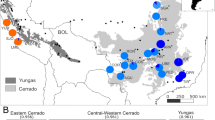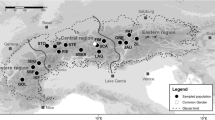Abstract
Bromus tectorum, an inbreeding annual grass, is a dominant invader in sagebrush steppe habitat in North America. It is also common in warm and salt deserts, displaying a larger environmental tolerance than most native species. We tested the hypothesis that a suite of habitat-specific B. tectorum lineages dominates warm desert habitats. We sampled 30 B. tectorum Mojave Desert and desert fringe populations and genotyped 10–26 individuals per population using 69 single nucleotide polymorphic (SNP) markers. We compared these populations to 11 Great Basin steppe and salt desert populations. Populations from warm desert habitats were dominated by members of two haplogroups (87 % of individuals) that were distinct from haplogroups common in Great Basin habitats. We conducted common garden studies comparing adaptive traits and field performance among haplogroups typically found in different habitats. In contrast to the haplogroup abundant in sagebrush steppe, warm desert haplogroups generally lacked a vernalization requirement for flowering. The most widespread warm desert haplogroup (Warm Desert 1) also had larger seeds and a higher root:shoot ratio than other haplogroups. In the field, performance of warm desert haplogroups was dramatically lower than the sagebrush steppe haplogroup at one steppe site, but one warm desert haplogroup performed as well as the steppe haplogroup under drought conditions at the other site. Our results suggest that B. tectorum succeeds in widely disparate environments through ecotypic variation displayed by distinct lineages of plants. Accounting for this ecotypic variation is essential in modeling its future distribution in response to climate change.






Similar content being viewed by others
References
Bossdorf O, Lipowsky A, Prati D (2008) Selection of preadapted populations allowed Senecio inaequidens to invade Central Europe. Divers Distrib 14:676–685
Bradley BA (2009) Regional analysis of the impacts of climate change on cheatgrass invasion shows potential risk and opportunity. Glob Change Biol 15:196–208
Broennimann O, Treier UA, Müller-Schärer H, Thuiller W, Peterson A, Guisan A (2007) Evidence of climatic niche shift during biological invasion. Ecol Lett 10:701–709
Brooks ML (1999) Habitat invasibility and dominance by alien annual plants in the western Mojave Desert. Biol Invasions 1:325–337
Caldwell M (1985) Cold desert. In: Chabot B, Mooney H (eds) Physiological ecology of North American plant communities. Springer, Berlin, pp 198–212
Chapin FS III, Autumn K, Pugnaire F (1993) Evolution of suites of traits in response to environmental stress. Am Nat 142:S78–S92
Davidson AM, Jennions M, Nicotra AB (2011) Do invasive species show higher phenotypic plasticity than native species and if so, is it adaptive? A meta-analysis. Ecol Lett 14:419–431
Dlugosch K, Parker I (2007) Molecular and quantitative trait variation across the native range of the invasive species Hypericum canariense: evidence for ancient patterns of colonization via pre-adaptation? Mol Ecol 16:4269–4283
Dobson AJ, Barnett A (2008) An introduction to generalized linear models, 3rd edn. Chapman and Hall/CRC, Boca Raton
Early R, Sax DF (2014) Climatic niche shifts between species’ native and naturalized ranges raise concern for ecological forecasts during invasions and climate change. Glob Ecol Biogeogr 23:1356–1365
Ehleringer J (1985) Annuals and perennials of warm deserts. In: Chabot B, Mooney H (eds) Physiological ecology of North American plant communities. Springer, Berlin, pp 162–180
Ersts PJ (2013) Geographic distance matrix generator (version 1.2.3). American Museum of Natural History. Center for Biodiversity and Conservation. http://biodiversityinformatics.amnh.org/open_source/gdmg. Accessed 20 Oct 2013
Excoffier L, Laval G, Schneider S (2005) Arlequin ver. 3.0: an integrated software package for population genetics data analysis. Evol Bioinform 1:47–50
Felsenstein J (1989) PHYLIP-phylogeny inference package (Version 3.2). Cladistics 5:164–166
Fulton TM, Chunwongse J, Tanksley SD (1995) Microprep protocol for extraction of DNA from tomato and other herbaceous plants. Plant Mol Biol Rep 3:207–209
Haubensak KA, D’Antonio CM, Embry S et al (2014) A comparison of Bromus tectorum growth and mycorrhizal colonization in salt desert vs. sagebrush habitats. Rangel Ecol Manag 67:275–284
Henery ML, Bowman G, Mraz P, Treier UA, Gex-Fabry E, Schaffner U, Müller-Schärer H (2010) Evidence for a combination of pre-adapted traits and rapid adaptive change in the invasive plant Centaurea stoebe. J Ecol 98:800–813
Hijmans RJ, Cameron SE, Parra JL, Jones PG, Jarvis A (2005) Very high resolution interpolated climate surfaces for global land areas. Int J Climatol 25:1965–1978
Hulbert LC (1955) Ecological studies of Bromus tectorum and other annual bromegrasses. Ecol Monogr 25:181–213
Hunter R (1991) Bromus invasions on the Nevada Test Site: present status of B. rubens and B. tectorum with notes on their relationship to disturbance and altitude. Great Basin Nat 51:176–182
Kent M, Gill WJ, Weaver RE, Armitage RP (1997) Landscape and plant community boundaries in biogeography. Prog Phys Geogr 21:315–353
Lachmuth S, Durka W, Schurr FM (2010) The making of a rapid plant invader: genetic diversity and differentiation in the native and invaded range of Senecio inaequidens. Mol Ecol 19:3952–3967
Lara DR (2013) Population genetic structure of Bromus tectorum in the American Desert Southwest. M.S. Thesis, Brigham Young University, Provo, Utah
Lavergne S, Molofsky J (2007) Increased genetic variation and evolutionary potential drive the success of an invasive grass. Proc Natl Acad Sci USA 104:3883–3888
Leger EA, Espeland EK, Merrill KR, Meyer SE (2009) Genetic variation and local adaptation at a cheatgrass (Bromus tectorum) invasion edge in western Nevada. Mol Ecol 18:4366–4379
Lloret F, Casanovas C, Penuelas J (1999) Seedling survival of Mediterranean shrubland species in relation to root: shoot ratio, seed size and water and nitrogen use. Funct Ecol 13:210–216
Mack RN (1981) Invasion of Bromus tectorum L. into western North America: an ecological chronicle. Agro-Ecosystems 7:145–165
Mantel N (1967) The detection of disease clustering and a generalized regression approach. Cancer Res 27:209–220
Merrill KR (2011) Usage and development of molecular markers for population and ecological genetic studies of Bromus tectorum L. Master’s Thesis. Brigham Young University, Provo, Utah
Merrill KR, Meyer SE, Coleman CE (2012) Population genetic analysis of Bromus tectorum (Poaceae) indicates recent range expansion may be facilitated by specialist genotypes. Am J Bot 99:1–9
Meyer SE (1978) Some factors governing plant distributions in the Mojave–Intermountain Transition Zone. Great Basin Nat Mem 2:197–207
Meyer SE, Allen PS (1999) Ecological genetics of seed germination regulation in Bromus tectorum L. I. Phenotypic variance among and within populations. Oecologia 120:27–34
Meyer SE, Nelson DL, Carlson SL (2004) Ecological genetics of vernalization response in Bromus tectorum L. (Poaceae). Ann Bot 93:653–663
Meyer SE, Ghimire S, Decker S, Merrill KR, Coleman CE (2013) The ghost of outcrossing past in downy brome, an inbreeding annual grass. J Hered 104:476–490
Mimura M, Ono K, Goka K, Hara T (2013) Standing variation boosted by multiple sources of introduction contributes to the success of the introduced species, Lotus corniculatus. Biol Invasions 15:2743–2754
Moles AT, Westoby M (2004) Seedling survival and seed size: a synthesis of the literature. J Ecol 92:372–383
Neuffer B, Hurka H (1999) Colonization history and introduction dynamics of Capsella bursa-pastoris (Brassicaceae) in North America: isozymes and quantitative traits. Mol Ecol 8:1667–1681
Novak SJ, Mack RN (2001) Tracing plant introduction and spread: genetic evidence from Bromus tectorum (Cheatgrass). Bioscience 51:114–122
Pawlak AR, Mack RN, Busch JW, Novak SJ (2015) Invasion of Bromus tectorum (L.) into California and the American Southwest: rapid, multi-directional and genetically diverse. Biol Invasions 17:287–306
Petitpierre B, Kueffer C, Broennimann O, Randin C, Daehler C, Guisan A (2012) Climatic niche shifts are rare among terrestrial plant invaders. Science 335:1344–1348
Prentis PJ, Wilson JR, Dormontt EE, Richardson DM, Lowe AJ (2008) Adaptive evolution in invasive species. Trends Plant Sci 13:288–294
Ramakrishnan AP, Meyer SE, Waters J, Stevens MR, Coleman CE, Fairbanks DJ (2004) Correlation between molecular markers and adaptively significant genetic variation in Bromus tectorum (Poaceae), an inbreeding annual grass. Am J Bot 91:797–803
Ramakrishnan AP, Meyer SE, Fairbanks DJ, Coleman CE (2006) Ecological significance of microsatellite variation in western North American populations of Bromus tectorum. Plant Species Biol 21:61–73
Rambaut A (2012) Figtree: Tree Figure Drawing Tool Version 1.4.0. Institute of Evolutionary Biology, University of Edinburgh
Reveal JL (1980) Biogeography of the Intermountain region: a speculative appraisal. Mentzelia 4. Northern Nevada Native Plant Society, Reno, NV
Rice KJ, Black R, Radamaker G, Evans R (1992) Photosynthesis, growth, and biomass allocation in habitat ecotypes of cheatgrass (Bromus tectorum). Funct Ecol 6:32–40
Scott JW, Meyer SE, Merrill KR, Anderson VJ (2010) Local population differentiation in Bromus tectorum L. in relation to habitat-specific selection regimes. Evol Ecol 24:1061–1080
Simberloff D (2009) The role of propagule pressure in biological invasions. Annu Rev Ecol Evol Syst 40:81–102
Slatyer RA, Hirst M, Sexton JP (2013) Niche breadth predicts geographical range size: a general ecological pattern. Ecol Lett 16:1104–1114
Sokal R, Michener C (1958) A statistical method for evaluating systematic relationships. University of Kansas Science Bulletin 38:1409–1438
Sultan SE (2000) Phenotypic plasticity for plant development, function and life history. Trends Plant Sci 5:537–542
Venable DL, Brown JS (1988) The selective interactions of dispersal, dormancy, and seed size as adaptations for reducing risk in variable environments. Am Nat 140:360–384
Young JA, Tipton F (1990) Invasion of cheatgrass into arid environments of the Lahontan Basin. In: McArthur ED, Romney EM, Smith SD, Tueller PT (eds) Proceedings—symposium on cheatgrass invasion, shrub die-off, and other aspects of shrub biology and management. Las Vegas, Nevada, April 5–7. 1989. Gen. Tech. Rep. INT-276. Ogden, UT: U.S. Department of Agriculture, Forest Service, Intermountain Research Station, pp 37–40
Acknowledgments
This work was supported in part by grants from the USDA Cooperative State Research Service (2008-35320-18677 to S.E.M. and C.E.C.), the Joint Fire Sciences Program (JFSP-2007-1-3-10, JFSP-2011-S-2-6 to S.E.M.), the Bureau of Land Management (Integrated Cheatgrass Die-off Research Project to S.E.M. and E.A.L.), and the University of Nevada Reno (start-up funds to E.A.L.). Thanks to Phil Allen, Joshua Nicholson, David Salman, and Bettina Schultz for seed collection, to Keith Merrill and Sam Decker for help with the SNP analysis, to Suzette Clement and Joshua Nicholson for assistance with the field study in Utah, to Sandra Li, Owen Baughman, Bryce Wehan, and Erin Goergen for field and greenhouse assistance in Nevada, and to Bettina Schultz for preparing the color graphics.
Author information
Authors and Affiliations
Corresponding author
Electronic supplementary material
Below is the link to the electronic supplementary material.
10530_2016_1105_MOESM1_ESM.pdf
Online Resource 1: Expanded version of dendrogram in Fig. 3 with all branch tips labeled, along with explanatory material relating SNP haplotype groups to SSR haplotypes reported in earlier work. (PDF 1770 kb)
Appendices
Appendix 1
See Table 5.
Appendix 2
See Fig. 7.
Precipitation during field studies at the Peavine, Nevada and Davis Mountain, Utah field sites. Values are monthly totals immediately preceding and during the field study period, and 30 year averages (1981–2010) for each site, from the Prism Climate Group (http://www.prism.oregonstate.edu)
Appendix 3
See Fig. 8.
Differences in percent emergence, survival, and flowering among SNP haplotype groups for Bromus tectorum plants at the Utah and Nevada common gardens, presented as the percentage of seeds planted that emerged, survived, and flowered (means and standard errors). Data were analyzed on a per seed basis, as described in the main text, and letters indicating significant differences among haplotype groups are from Tukey’s HSD tests from those analyses
Rights and permissions
About this article
Cite this article
Meyer, S.E., Leger, E.A., Eldon, D.R. et al. Strong genetic differentiation in the invasive annual grass Bromus tectorum across the Mojave–Great Basin ecological transition zone. Biol Invasions 18, 1611–1628 (2016). https://doi.org/10.1007/s10530-016-1105-6
Received:
Accepted:
Published:
Issue Date:
DOI: https://doi.org/10.1007/s10530-016-1105-6






